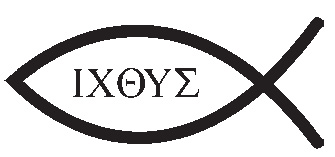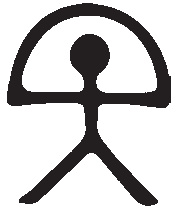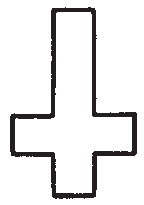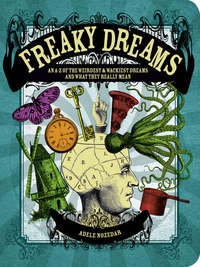
Полная версия
The Element Encyclopedia of Secret Signs and Symbols: The Ultimate A–Z Guide from Alchemy to the Zodiac
The I Ching, or Book of Changes, was the only book that escaped destruction when all the Chinese philosophical works were burned in the third century BC. Either dried yarrow stalks or special coins, usually with square holes in the center, plus knowledge and a fair sprinkling of intuition, are the tools of the I Ching.
The basis of the system is just two simple lines, one continuous, one broken. The most profound symbols are usually the simplest, and these two lines encompass the universal source of all things, also known as the Tao (as in Taoism).
The unbroken line represents all aspects of the positive; male, Sun, fire, heat, action, odd numbers, yang. The broken line represents the opposites.
These lines combine to make 64 possible combinations.
The lines also form a set of eight trigrams that represent the elements of air, water, fire, and earth, with the four sub-elements of breath, sea, thunderbolt, and mountain.
The interpretations of the I Ching are beautifully oblique; the philosophy behind this system is about finding balance. Both the flags of Vietman and of South Korea feature trigrams from the I Ching.
ICELANDIC STAVE SYMBOLS
Early Icelandic grimoires (magical texts full of spells and occult information) contain long lists of curious, angular-looking symbols, all intended for a specific purpose. Their origins go back to the ancient rune system, with a sprinkling of later medieval and Renaissance magic thrown in for good measure.
The purposes of the symbols tell the story of the lifestyles and concerns of the people down the passage of the years; the importance of a good catch for fishermen, protection against thieves and ghosts, how to frighten away enemies.
The intentions of these ancient symbols are extremely varied and there seems to be one for almost every conceivable occasion. The lists read a little bit like a magical book of household management. There are staves included to help ensure the quality of butter, for lock breaking, and even for raising the dead.
Popularly referred to as Magical Staves, these signs are sometimes comprised of several runic symbols merged together (a bind rune), while others stand alone.
AEGISHJALMUR

One of these stave symbols is called the Helm of Awe or Aegishjalmur. It looks like a snowflake, except it has eight arms radiating from the central point instead of six.
Its purpose, as the name suggests, was to instill fear in the hearts of enemies and to guard the wearer against abuse of his own power. To work properly it needs to be engraved onto lead and then pressed into the forehead.
Latterly, followers of the Asatru belief adopted the Helm of Awe as one of their cornerstone symbols.
HULINHJALMUR: TO MAKE YOURSELF INVISIBLE

Although invisibility is likely to be an incredibly useful asset, the construction of this stave is particularly tricky. It might not seem too difficult to engrave it on a piece of lignite using magnetic steel that has been hardened by soaking in human blood, but the instructions for blending of the ink could be a real nuisance. The recipe calls for three drops of blood from the index finger of the left hand, and three from the ring finger of the right hand; two drops of blood from the right nipple and one from the left. To this is added six drops of blood from the heart of a living raven. All this blood needs to be melted down with the raven’s brain and parts of a human stomach. Voilà. Now you see me…
DISCLAIMER
Hulinhjalmur, it will be noted, has no counter stave to restore visibility. Neither the author nor the publishers of this book accept any responsibility for misuse of rune staves.
ICHTHYS WHEEL

At first glance, this looks like a simple six-spoked wheel. However, the name of Christ is cleverly hidden within it, and like the vesica piscis, was a way for early, persecuted Christians to recognize one another. The Greek letters I X O Y E can be laid over the circle.
I H S

These initials form a symbolic monogram for Christ. The monogram comprises the letters iota, ete, and sigma, which are the first three letters of the name of Jesus in Greek, Iesous. The letters also stand for the Latin phrase, Iesous Hominum Salvator, meaning Jesus, Saviour of Man.
Later, the symbol became a sign of peace.
The IHS symbol is generally embossed onto the communion wafer, and the initials surrounded by the rays of the Sun.
INCENSE

Its origins in incendere, the Latin word for fire, the importance of incense as a magical symbol lies in the resins and spices that it is made from, its perfume, and the action of its smoke that rises up toward the sky. This smoke is believed to conduct prayers, messages, and devotions toward the deities. The scent is said to please the Gods as well as lifting the spirits of worshippers, and the fact that frankincense was one of the three gifts given by the Wise Men to the infant Christ is a reminder of its significance. In Christianity, incense was first used in burials as a symbol of purity that would drive away demons and to carry the soul up to Heaven. However, its use soon expanded, and today, incense has a prominent part to play in rites of all kinds, especially within the Roman Catholic Church and the High Church of England. Neopagan groups, too, use incense for the same reasons.
Burning of incense transcends faiths and cultural boundaries. For Native Americans, the fragrant smoke given off by tobacco and other herbs when they share the calumet or pipe carries exactly the same significance as the incense that is burned in churches and the “dhupa” (or dhoop sticks) of Hindu ritual. For Hindus, incense represents the element of air and the perception of consciousness.
The tower of smoke that rises up from the incense is symbolic of the Axis Mundi.
Practitioners of ceremonial magic might use incense so that disembodied entities, such as elementals or other spirits, might use the smoke to make themselves manifest.
INDALO

This is a prehistoric symbol of magical significance, found in caves in the Almeira region of Spain and known to have been created about 5000 years ago.
The symbol is very simple, showing a stick man holding an arch above his head. The arch represents either a rainbow or the vault of the Heavens. Indalo was perceived to be a go-between between man and God, the rainbow providing a bridge between Heaven and Earth. This sign, which looks like a child’s drawing, serves as a reminder of the complex belief of man as the microcosm and the Universe as the macrocosm.
The Indalo figure has become a logo for the village of Mojacar in particular and for the whole area in general. Sometimes he is called Mojacar Man.
INFINITY

Often the simplest symbols are the ones with the richest meanings. The infinity sign, the figure of eight, and the lemniscate all refer to the same shape that contains a wealth of complex meaning within its fluid lines. This mysterious symbol is found on an everyday object, the camera, where it appears as the infinity lens focus.
To get a sense of what the infinity sign is and how it feels, find something circular and flexible—an elastic band will do. Then twist it once. That is the lemniscate. The flat, one-dimensional circle is suddenly lent a new dimension by this simple twist.
As a mathematical device, the infinity sign was first “discovered” in 1655 by John Wallis, but its significance as a religious symbol is much older.
The infinity sign has its origins in the Arabic numerals that actually came from India in the first place. The sign can be drawn in one continuous movement, making a seesaw movement of clockwise and counterclockwise loops. These loops reflect the balance of opposites; male and female, day and night, dark and light. Because the circles of the lemniscate sit side by side, the sign implies equality between these opposing forces, with the connecting point in the center the convergent point. The sign epitomizes the idea of sexual union and of “two becoming one.” The infinity sign stands for wholeness and completion.
The lemniscate appears in the elaborate curlicues in Arabic calligraphic renderings of the Name of God; the elegant loops providing a decorative device as well as pointing toward the idea of eternity.
The symbol appears in the Tarot, as part of the Magician card. In the Pamela Colman/Rider-Waite version, the magician has the lemniscate floating boldly above his head; in other decks, the brim of his hat conceals the shape. Disguising the symbol in this way is a suitable device for such a mysterious character.
INVERTED CROSS

The “upside down” crucifix, or Cross of St. Peter, has become a sinister symbol purportedly belonging to Satanists, whose penchant for reversing certain aspects of the Christian faith (such as the Mass and the Lord’s Prayer) is well documented. In horror movies the inverted cross represents the Devil. However, the inverted cross originated as the type of cross upon which St. Peter chose to be executed since, like St. Andrew, he felt unworthy of being crucified on the same type of cross as Christ. Devout Catholics view this particular cross as a sign of deep humility and unworthiness in the sight of the Messiah. The Pope is said to be the successor of St. Peter and so, logically, has been photographed with this type of cross in the background, giving rise to hysterical conspiracy theories about satanic influences within the Catholic Church.
IRMINSUL

This early Anglo-Saxon symbol has been adopted as one of the cornerstone signs of the Asatru religion. It takes the form of a single pillar, with an ornamented cross bar or a Sun wheel surmounting it.
The word itself means “great pillar” and it is connected to the Nordic World Tree, or Yggdrasil, that connects the Earth with the Heavens. The root of its name is shared not only by Yggdrasil but also by the God, Odin, and is a clue to the close connection between the three.
JAIN SYMBOL

Also called the Parasparopgraho Jivanam, this sacred symbol of the ancient Jain faith (an offshoot of Hinduism) is constructed from several other signs and symbols.
First, the outline of the symbol is called the Lok and is representative of the Universe. The lower part reminds Jains of the concept of Seven Hells. The central part represents the Earthly plane, and the upper portion represents the Heavens. Then, working from the top down, the curved arc represents not only the Moon, but is called the Siddhasila, the final resting-place of souls that have been liberated from the karmic wheel of death and rebirth. These souls are called Siddhas.
The dot or bindhu within the arc is indicative of the zero, the every thing and the nothing combined. It is also representative of the Siddha.
Below the arc are three further bindhu. These represent the Three Jewels of Jainism, namely, the rules for attaining the desired liberation of the soul. These rules are:
Right Faith (Samyak Darshan)
Right Knowledge (Samyak Jnan)
Right Conduct (Samyak Charitra)
Below these three sacred dots is the swastika, the very ancient solar symbol. Here, the four arms of the swastika symbolize the four realms into which a soul may be reborn; a soul can become a heavenly being, a human being, an animal being, or a hellish being.
Underneath the swastika is the upraised hand, a universal symbol meaning “Stop!” Inside the hand is the word “Ahimsa,” one of the tenets of Hinduism and Jainism, which is an offshoot of this faith. Ahimsa means “nonviolence” and the word itself is contained within a wheel. The combination of the hand and the word within the wheel are a reminder to stop and think before acting, to do nothing which could harm any creature, otherwise the wheel of birth and rebirth will keep on turning and the soul will never be liberated.
JAPA MALA
See Rudraksha.
JERUSALEM CROSS

This is one large cross with smaller crosses in between the arms. Originally used by the Crusaders, hence its name, the five crosses symbolize the five wounds of Christ.
JEWELRY
The precious metals and beautiful gems that make up jewelry spring from the womb of the Earth. Legends tell us that these gems are mined by dwarves and that jewelry is constructed by elves and goblins. Metals and gems are themselves full of hidden meanings. Gems symbolize not only material wealth but also wisdom and the riches of the mind and spirit. Buddhist doctrines are called “jewels.” And, as the song says, diamonds really are forever! Not only the stones, but also the precious materials that go into the design of jewelry, are eternal and incorruptible. Ancient jewelry often looks as new as the day it was made, and was worn by royalty as well as the common man.
There is evidence that man adorned himself with jewelry as long ago as 40,000 years, and the very earliest kind was made of shells, animal bones and teeth. The importance of this jewelry was such that people were even buried with it.
Jewelry is not only decorative: it can be functional, too, for instance, to hold clothing together (buckles, brooches, pins, and clips). It stores wealth (think of the archetypal gypsy, dripping gold—this jewelry is the same as money in the bank). Jewelry can take the form of protective amulets and talismans, with countless designs intended specifically to avert the evil eye. It also denotes status or membership of a group or tribe, or can give information about the wearer, for example, the wedding ring as a symbol of binding, or the jet mourning jewelry worn by bereaved Victorians. In Rome, the Sumptuary Laws gave instructions as to who had the right to wear specific sorts of jewelry.
The wearing of religious symbols, like the crucifix or Star of David, may sometimes be the cause of contention because of a lack of understanding of religious and cultural values. For example, a woman working at a major airport in the UK was told that her crucifix could be offensive. In addition, there have been instances where the facial jewelry of some Hindus has been looked at askance by people who do not understand the reasons for this adornment. A deeper understanding of the reasons that people choose to wear certain jewelry can only help to bring more harmony between diverse cultures. The nose ring, for example, is a practice copied from Indian cultures where piercing is believed to enhance fertility.
RING
Wearing a ring indicates a link or bond; the wedding ring is the perfect example of this. In J. R. R. Tolkein’s The Lord of the Rings, the mystical ring bears the inscription “one ring to bind them.” The Fisherman’s Ring, which is exclusive to the Pope, is used as his personal seal, being broken when he dies.
The ring, of course, is a circle, and so it carries all the symbolic significance of the shape; eternity and unity. The signet ring has a personal seal or other hieroglyphic device engraved on it used as a sign of identity.
Solomon had a particularly magical ring, the possible source of all his wisdom. He used it to conjure up the demons that then became his slaves, but when he lost the ring all his wisdom disappeared too, until the ring was returned to him.
Plato describes a ring that belonged to the shepherd, Gyges. His ring had a rotating bezel that, if turned inward, made him invisible.
The fingers on which rings are worn also have significance. The fourth finger of the left hand that is traditionally designated for the wedding or engagement ring has a direct link to the heart. Archers in China and Persia wore rings to protect their thumbs, so the thumb ring indicated military rank. A ring worn on the index or “pointing” finger indicates authority.
In India, toe rings, or bichiya, also denote status. Worn on the second toes of both feet they are a sign of marriage. Hindus traditionally consider it disrespectful to wear gold below the waist so these rings are usually, but not always, made of silver.
NECKLACE
A necklace is a sign of identity, more visible and more immediately obvious than the ring. For example, it can signify a chain of office (as in the ornate mayoral necklace) or a chain of bondage, like the collars worn by slaves. The Goddess Kali is immediately identifiable by her necklace of human skulls, and witches traditionally wear a necklace of acorns. Amulets and talismans often appear as pendants, and lockets of all kinds store hidden information.
JIZO

This is a Japanese Buddha symbol. Almost cartoonlike, Jizo is depicted as an innocent, childlike character, venerated as a protector of the souls of children and unborn babies.
Jizo is ubiquitous in Japan, often appearing as a statuette dressed in robes. People also surround the Jizo statuette with offerings of food, sweets, incense, and pebbles.
KABBALAH

YAH, the Lord of Hosts, the living Elohim, King of the Universe, Omnipotent, the Merciful and Gracious God, Supreme and Extolled, Dweller in the Height whose habitation is Eternity, who is Sublime and Most Holy, engraved His name and ordained the Universe in thirty-two mysterious paths of wisdom, by the three Sephariam, namely, Numbers, Letters and Sounds, which are in Him and one and the Same
(from the Sefer Yetzirah)
A VERY SHORT HISTORY
Most systems of faith have an exoteric, or external level of understanding that is aimed at the masses, and an esoteric, or inner level of meaning that is the preserve of the priests and initiates. The deeply mystical Kabbalah is the enigmatic aspect of the Jewish doctrine. The word has its root in Hebrew, QBL, meaning “to receive” or alternately “mouth to ear,” or “the unwritten law,” and like most mystery traditions its secrets were originally communicated orally. It shares the same root as the word “Cabal,” meaning “secret intrigue.”
These secrets, so the story goes, were given directly from God to the Archangels who then passed the information on to Adam after his expulsion from the Garden of Eden, in order that he might regain his former favor in the eyes of God. The secrets passed through Noah to Abraham, who shared the mysteries with the Egyptians. From here the Kabbalah spread to other parts of the world. Moses, too, had kabbalstic instruction directly from God. According to Jewish mystics, the third time he climbed Mount Siani he spent forty days learning its secret doctrine from the angels while he was wandering in the Desert. Thereafter, Moses concealed the teachings that appeared for the first time in written form in the first four books of the Old Testament.
In the first century, Rabbi Simeon Ben Jochai had to hide in a cave with his son for twelve years, avoiding execution because of his criticism of the Roman Empire. During this time, the Rabbi taught the secrets of the Kabbalah to his son, and these teachings appeared as a book, published in thirteenth-century Spain, called the Zohar. It is this book which is the cornerstone of the Kabbalistic doctrines.
The universality of the ideas within the Kabbalah means that it has been adopted by numerous different religions. Not surprising, since the beauty and logic of its construction is awe-inspiring and all-encompassing. There was a general upsurge of interest in esoterica in the Middle Ages and this era saw the development of a Hermetic Kabbalah, a combination of Kabbalistic teachings and Greek hermeticism. In turn, alchemy and Rosicrucianism were influenced by its secrets, as was Freemasonry. The Tarot takes its influence from the Kabbalah. The Golden Dawn based its symbolic language on that of the Kabbalah. Its influence has been all pervasive, thousands of years after the angels imparted its intricacies to the First Man.
The doctrines encompass The Four Worlds and The Tree of Life, while the latter, in turn, encompasses The Ten Numbers and The 22 Letters.
THE FOUR WORLDS
The Greatest Name, Jehovah, or IHVH, has an element attached to each letter. Further, the letters also represent the Four Worlds. These are Atziluth (emanation), the world of pure spirit, an archetypal world where there is no separation or division. This is the world of the Gods. Atziluth is associated with the element of fire and the letter I, and from it the other three worlds are “born.”
Briah, “cosmos” or “creation,” is the next world, represented by the letter H and the water element. This is the world where separation begins, where one idea might separate from others, although this world is still formless.
Yetzirah, represented by the V and the element of air, is the next world born from Briah. This is the domain of imagination and thought, corresponding to the astral world, a level of consciousness that immediately precedes the physical.
The fourth world is Assiah, which means “to do.” Assiah is the material world, represented by the final letter H and the earth element. It is the here and now, our physical reality, the world of separation that is constructed from the finer elements that precede it.





